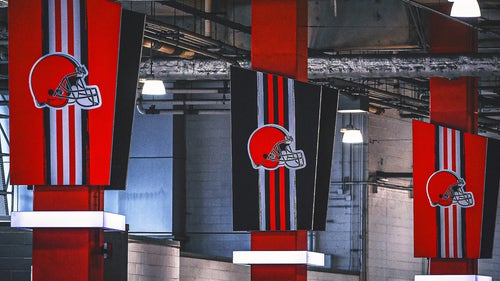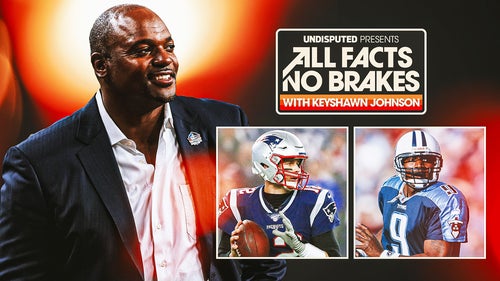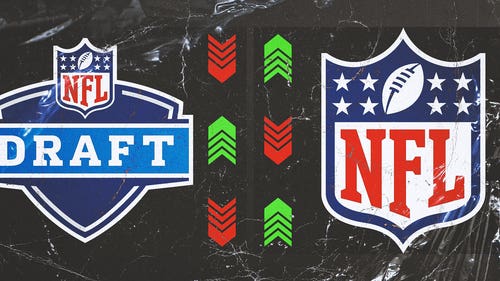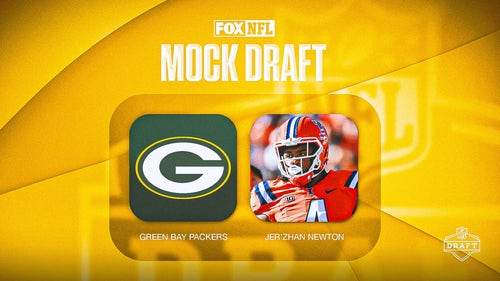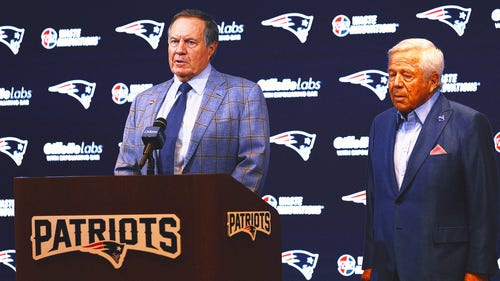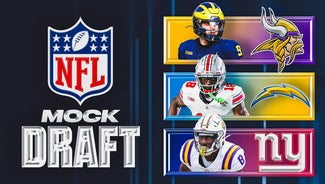
Behind the scenes of a heavily caffeinated NFL Sunday in the Red Zone

LOS ANGELES — The early Sunday slate for Week 8 is in its waning minutes, and the soundtrack for tens of thousands of NFL fans emanates from a dark room in the middle of a nondescript Southern California office park. Andrew Siciliano, in a suit and glossy dress shoes, paces his circular stage, no larger than a college dorm room. He picks at a leafy salad from a styrofoam container as his eyes dart across the wall in front of him: monitors showing all seven live NFL games. This is the DirecTV Red Zone, where there's no time for nuance and little respect for downs before the 50. In the span of 90 seconds, Siciliano guides viewers through five scenes with a familiar, if dizzying, rhythm.
"After a beautiful play by David Johnson, Carson Palmer and company are now threatening. Two and a half to go, third quarter."
"Now this is Raymond James in the right side of your screen, the Buccaneers, after a 42-yard play to Adam Humphries, they are in the red zone..."
"Carson Palmer second down, incomplete."
"Now Jameis Winston, back of the end zone, that's Cameron Brate, and that's a touchdown."
"Nick Foles just connected with Chris Conley for 33 yards, they are now at the Indianapolis 38-yard line; Alex Smith has been ruled out for the rest of the day."
Ten minutes later, action has picked up and Siciliano puts his lunch aside. As seven quarterbacks march on scoring drives, Siciliano consults the two research assistants standing beside him and the producer in a faraway room. "Hey Bill, what's happening on [screen] one?" Siciliano asks off-air, looking at the Patriots-Bills tilt. "Get ready for one."
"No, wait," the host interjects, directing his attention to screen six: Detroit at Houston, where the Lions are about to kick a field goal. "Let's show six." He takes three steps to the left and takes a look at the Buccaneers game on screen four. "Or wait, four! There's a two-point conversion!" Siciliano shouts. "Can we show four? Four, four, four!"
The feed can't switch fast enough. The director already has cut to screen six, Houston. Siciliano stomps his foot and mouths "Dammit!" They didn't show the more exciting play live. No time for regrets, though: Siciliano jumps back into the flow to narrate Matt Prater's 34-yard field goal and then a quick replay of the Tampa Bay conversion.
"Let's go here, this is Houston, this is a field goal to make it a one-score game. That field goal is good, so it's 20-13. But the Buccaneers just got a two-point conversion to extend the lead to seven. Mike Evans there from Jameis Winston and we will go to Carolina...."
Off air again, Siciliano lets out an exaggerated sigh. "That was my bad," he says. He glances across the spread of screens and fixes on Colts-Chiefs, which is coming back from commercial. "Wait, is that a monkey?" Siciliano asks. "Can somebody find out if that's a monkey on the screen?" And now he has another decision to make.
DirecTV's Red Zone has been a prominent Sunday player since its debut in 2005. This week marks the show's 200th episode. It is important to note that there are two nearly identical channels — the other, NFL Network's RedZone, hosted by Scott Hanson — that offer live whip-around coverage of Sunday football. Though Chris Long, executive producer of DirecTV's version, insists the shows are distinguished by personality (as well as whether or not there's a space between words in the show title), the truth is that a viewer doesn't get to choose between Hanson and Siciliano; it depends on what provider you subscribe to. Siciliano's show is only available through DirecTV's Sunday Ticket package; Hanson's show is carried on cable as well as Dish TV and some smartphones.
"If you juxtapose them next to each other, they are different broadcasts, there's a different flavor," Long says. "It does seem odd that there are two channels offering the same thing, and who knows — one day down the road we can affect change and combine them."
The continuous action at breakneck speed (no commercials, no airing of punts) caters to America's collectively shrinking attention span. As 2016 launched the debate on the future of NFL broadcast consumption — with a sharp decrease in television viewers over the season's first half — it is notable that Long says Red Zone is as healthy as ever. In fact, though DirecTV does not report its viewership numbers, Long says there has been "an uptick" this season. (There also has been an uptick in DirecTV's fantasy-centric programming, Long says).

This can be framed in two ways: Either Red Zone was progressive in its launch a decade ago, foreseeing how fans wanted to watch football, or it has itself been an agent of change, eroding the viewer's willingness to sit passively through those three-hour single-game blocks.
"I don't know if we deserve credit or blame for how viewing habits are evolving," Siciliano says. "We did not invent the cell phone, we did not invent social media or fantasy football, or many of the things that distract us now from sitting down and watching a full game. We're certainly not the reason America has no attention span, but I know we haven't helped the problem. We've probably helped make it worse.
"Nobody has any patience anymore when a game slows down. They demand immediate action. If the game they're watching is boring, they want to find a better one. We were the show to give them that, where they didn't actually have to bother to pick up the remote.
"Look, those six and a half hours of NFL football on Sundays make for the most entertaining reality show on TV, and we want people to hand over the controls so we can highlight the best of it."
Siciliano, 42, has a cult following stemming in part from the show's mystique. He begins each Sunday with a live shot from a desk (hence the suit), then vanishes for six-plus hours, becoming Oz behind a veil of screens.
In its inaugural season, Siciliano didn't appear on camera at all. The show filmed in a much smaller studio with a green screen at FOX, and it had access to only FOX-broadcast games. "We needed to have Andrew show his face, if only for the beginning," Long says. "To establish that this is a real, produced sports show."
Siciliano's setup now includes a desk just big enough to hold his laptop and a cup of coffee. The computer is booted up with exactly two screens: Siciliano's Gmail account, and TweetDeck, which he constantly scans through the broadcast.
"We used to have a chair for him," says James Crittenden, another executive producer, "but we ended up taking it away, probably after a half a season, because he never used it."
Instead, Siciliano paces, squats, jumps and occasionally pumps his fist. At one point, as refs huddle to determine a contested catch, Siciliano acts out the play himself, demonstrating both feet touching the ground. His unwavering enthusiasm radiates on the broadcast, but his constant movement raises the question of why, since he doesn't appear on air after the opening setup, he doesn't change into more comfortable clothing — or at the very least, running shoes. "That's a good point, especially because I have a bad back," Siciliano says. He adds that he does have "good insoles."
It is his voice — engaging, confident — that carries the show. One week earlier Siciliano battled a viral emergency. Over the course of the broadcast his voice began shriveling, to the point that he received a flurry of tweets from viewers wondering if he had taken a day off. "Even friends, good friends of mine, were reaching out, asking if it was really me," Siciliano says. "They turned on the TV and thought it was a hoax, that I wasn't really there." The following day he went straight to the doctor for an emergency steroid shot — but he didn't help his own case when on Tuesday he flew to Cleveland to watch his beloved Indians in Game 1 of the World Series.
This brings us to Siciliano's most notable quirk: his bathroom schedule (or rather, lack thereof). In short, he rarely takes a break during a broadcast. "I admittedly play it up a little bit," Siciliano says. "But it's real." When he arrives each Sunday at 7:30 a.m. local time, after downing a five-shot venti Americano, Siciliano records a series of transitions — "Meanwhile, we take you to Green Bay..." ... "Here we are, at Raymond James Stadium..." — that the director can use in the event that the host is, ahem, indisposed at some point during the show. It is a two-and-a-half minute exercise in futility; no one on the crew can remember the last time they had to deploy the prerecorded Siciliano. He has taken bathroom breaks, but they are rare, even as he drinks five more cups of coffee throughout the day. "The day I lost my voice, it was undeniable," he says. "I had to drink so much water and tea."
Despite the frenetic energy, the beauty of Red Zone is its familiarity. Since wholesale changes in Season 2 — notably the inclusion of all broadcast games in the 1 p.m. and 4 p.m. windows, not just FOX — not much has been altered. Siciliano integrates social media, both for information and to interact with fans, and graphics have been updated, but the show is otherwise nearly identical to its iteration a decade ago. "We feel like we hit jackpot," Long says. "If it hasn't changed in 10 years, I don't think it would change 10 years from now."
Siciliano does have a few ideas, though. "Not that I want to put myself out of a job, but I do think there will be some element where the viewer is connected and can have more control of what they're watching," he says. "Additionally, there will be an element of virtual reality. When I say, 'Let's go to AT&T Stadium, to see Dak Prescott here in his 10th season with the Cowboys,' all of the sudden your room will get brighter and you'll hear the sounds and feel like you're standing on the sideline in Dallas."
For now there is the Red Zone as we know it, and as Siciliano curates it. The machine is well-oiled. There is the crew member in the control room who listens to the feeds of broadcasts, waiting to pluck pertinent information, and the team that builds graphics for Siciliano to recite on air. There are the two researchers, Jayson Thibault and Daniel Burris, who stand by Siciliano's side, fielding frantic inquiries such as "How many field goals has Aguayo missed this year?" and "Who is No. 37 on white?" by scribbling answers on a piece of notebook paper and waving them in Siciliano's face. Much of the staff has been here as long as the host. On weekdays they scatter to their "day jobs" — many work production for The Rich Eisen Show or The Dan Patrick Show. Siciliano is a host on NFL Network, where he is, ironically, colleagues with Hanson. (The two have known each other since they were students at Syracuse; Siciliano says they have a good relationship but that, given his schedule, he has never seen Hanson's RedZone show. "I'm sure they do a good job," he says.)
But now, back to that monkey. "Do we know what's going on here?" Siciliano asks into his headset. It is determined that it is a live shot from the Indianapolis Zoo, and as a change of pace from the football action Siciliano decides they will show footage of the primate. "They just showed this, on the Indianapolis broadcast, that's a monkey at the Indianapolis Zoo," he narrates. "No monkeys riding dogs, but now we have this monkey. Thank you, thank you. Trying my best to entertain."
A few minutes later Siciliano checks Twitter, where a viewer has provided a correction.
"OK," Siciliano says. "Apparently that was an ape. Now back to what you came here for."
This article originally appeared on the MMQB.








































































































































